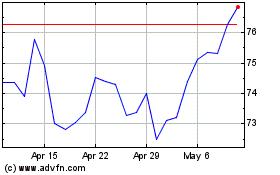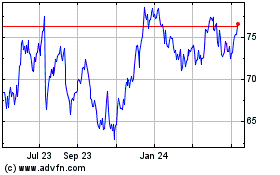Majority of Plan Participants Lost on Retirement Planning, Seek Direction from Employers, says Survey
January 25 2012 - 11:00AM
Business Wire
A survey released today by State Street Global Advisors (SSgA),
the asset management business of State Street Corporation (NYSE:
STT), suggests that employees around the country are in need of
direct, simple guidance to help them reach their retirement goals.
The SSgA Defined Contribution (DC) Investor survey was created to
reveal employees’ investing behaviors and interactions with their
retirement plans. Conducted jointly with the Boston Research Group,
the survey included over 1,000 401(k), 403(b), profit sharing and
stock purchase plan participants.1
The findings from the survey emphasize four areas of focus for
employers and their participants: attitudes toward saving for
retirement, awareness of automatic features in DC plans, awareness
of long-term investment risks and nuances among age groups that
impact likeliness to save.
“Plan participants communicated loud and clear about what they
need: simple steps and automated features,” said Kristi Mitchem,
senior managing director and head of Global Defined Contribution
for SSgA. “One of the most surprising and encouraging findings is
the willingness of participants to take 401(k) direction from their
employers. The ongoing volatility in the financial markets has
increased anxiety amongst plan participants and a significant
percentage want simplified and prescriptive guidance in order to
make progress toward their retirement goals.”
Attitudes towards saving are changing, with 75 percent of survey
respondents indicating they would be willing to be automatically
enrolled in a 10 percent savings “boot camp” for six months. The
survey concluded that 54 percent of participants say they are
“very” or “somewhat confident” that their savings are on track to
fund their planned retirement lifestyle. Other participants have a
much less optimistic outlook. Most place the blame on themselves,
with 55 percent indicating they lack confidence because their rate
of savings is not high enough and 52 percent indicating they did
not start saving early enough. Others blame the economy or the
financial markets, and only a few blame their employer.
“For the first time, DC assets will outnumber traditional
defined benefit assets globally in 20122, with DC assets increasing
to 52 percent of all retirement assets,” continued Mitchem. “This
statistic underscores the importance of improving interactions
between DC plan sponsors and plan participants by better
understanding the needs and savings behaviors of DC investors. Plan
participants typically do not take action for two reasons: lack of
knowledge or lack of time. As we design plans and engage employees,
the more we know about them, the bolder we can be with solutions
that will help them achieve retirement security. We have embedded
the survey results into a bi-annual magazine called ‘The
Participant’ to communicate these insights. The magazine is
designed to help plan sponsors deliver solutions that combat
barriers to retirement readiness and make a difference by
understanding employee needs and providing simple steps and tools
that plan participants can use to increase savings and address
investment risks, like inflation and company stock.”
Automatic features offered by employers to encourage
participants to save, such as auto-enrollment and auto-escalation,
are preferable but not well understood, with 74 percent of
respondents indicating that “making me automatically do something
like save more or invest in a professionally managed fund” would
improve their retirement readiness. Awareness of long-term
investment risks is limited, such as the risk associated with
inflation and ownership of company stock. Forty-three percent of
respondents that are aware of the US inflation rate have considered
its effects on their retirement, but do not know what to do about
it. Sixty-eight percent responded favorably to a plan solution that
not only limits the risk of a significant loss in their company
stock holdings, but also puts a small limit on the upside.
The impact of the financial crisis and the generational
differences in attitudes also impact retirement strategies.
Seventy-three percent of the youngest workers, ages 18-24, said the
recent volatility prompted them to save more, versus 37 percent of
the general population. Younger savers are more conservative and
more likely to save than their older counterparts.
“The market volatility has created a new generation of savers,”
Mitchem said. “Younger workers are saving more and spending less
than their parents, while 66 percent of those over 50 years of age
admit to not saving at an early enough age.”
For more information, or to subscribe to “The Participant”
magazine, visit: www.ssga.com/dc/theparticipant.
About State Street Global Advisors
State Street Global Advisors (SSgA) is a global leader in asset
management. The firm is relied upon by sophisticated investors
worldwide for its disciplined investment process, powerful global
investment platform and access to every major asset class,
capitalization range and style. SSgA is the asset management
business of State Street, one of the world's leading providers of
financial services to institutional investors.
About State Street Corporation
State Street Corporation (NYSE: STT) is one of the world's
leading providers of financial services to institutional investors
including investment servicing, investment management and
investment research and trading. With $21.8 trillion in assets
under custody and administration and $1.9 trillion* in assets under
management at December 31, 2011, State Street operates in 29
countries and more than 100 geographic markets. For more
information, visit State Street’s web site at
www.statestreet.com.
*This AUM includes the assets of the SPDR Gold Trust (approx.
$63 billion as of December 31, 2011), for which State Street Global
Markets, LLC, an affiliate of State Street Global Advisors serves
as the marketing agent.
1 The sample of 1,076 observations has a maximum sampling
error of +/-3 percentage points at a 95 percent confidence
level.
2 Source: McKinsey Retirement Practice, estimated figures.
The views expressed in this material are the views of SSgA
through the period ended January 25, 2012 and are subject to change
based on market and other conditions. This document contains
certain statements that may be deemed forward-looking statements.
Please note that any such statements are not guarantees of any
future performance and actual results or developments may differ
materially from those projected.
CORP-0438
State Street (NYSE:STT)
Historical Stock Chart
From Jun 2024 to Jul 2024

State Street (NYSE:STT)
Historical Stock Chart
From Jul 2023 to Jul 2024
